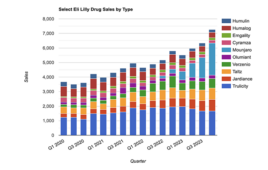 Tackling antibiotic resistance on only one front is a waste of time because resistant genes are freely crossing environmental, agricultural and clinical boundaries, new research has shown.
Tackling antibiotic resistance on only one front is a waste of time because resistant genes are freely crossing environmental, agricultural and clinical boundaries, new research has shown.
Analysis of historic soil archives dating back to 1923 has revealed a clear parallel between the appearance of antibiotic resistance in medicine and similar antibiotic resistant genes detected over time in agricultural soils treated with animal manure.
Collected in Denmark – where antibiotics were banned in agriculture from the 1990s for non-therapeutic use – the soil archives provide an ‘antibiotic resistance timeline’ that reflects resistant genes found in the environment and the evolution of the same types of antibiotic resistance in medicine.
Led by Newcastle University, UK, the study also showed that the repeated use of animal manure and antibiotic substitutes can increase the capacity of soil bacteria to mobilise, or ready themselves, and acquire resistance genes to new antibiotics.
Publishing their findings today in the academic journal Scientific Reports, the study’s authors say the data highlights the importance of reducing antibiotic use across all sectors if we are to reduce global antibiotic resistance.
Lead author David Graham, Professor of Ecosystems Engineering at Newcastle University, said:
“The observed bridge between clinical and agricultural antibiotic resistance means we are not going to solve the resistance problem just by reducing the number of antibiotics we prescribe in our GP clinics.
“To reduce the global rise in resistance we need to reduce use and improve antibiotic stewardship across all sectors.
“If this is not done, antibiotic resistance from imprudent sectors will cross-contaminate the whole system and we will quickly find ourselves in a situation where our antibiotics are no longer effective.”
Antibiotics have been used in medicine since the 1930s, saving millions of lives. Two decades later they were introduced into agricultural practices and Denmark was among the leaders in employing antibiotics to increase agricultural productivity and animal production.
However, a growing awareness of the antibiotic resistance crisis and continued debate over who and which activities are most responsible led to the EU calling for the use of antibiotics in non-therapeutic settings to be phased out and Denmark led the way.
The Askov Long-Term Experiment station in Denmark was originally set up in 1894 to study the role of animal manure versus inorganic fertilisers on soil fertility.
Analyzing the samples, the team – involving experts from Newcastle University, the University of Strathclyde and Aarhus University – were able to measure the relative abundance of specific β-lactam antibiotic resistant genes, which can confer resistance to a class of antibiotics that are of considerable medical importance.
Prior to 1960, the team found low levels of the genes in both the manured soil and that treated with inorganic fertiliser. However, by the mid 1970’s, levels of selected β-lactam genes started to increase in the manured soils, with levels peaking in the mid 1980’s. No increase or change was detected in the soil treated with inorganic fertiliser.
“We chose these resistant genes because their appearance and rapid increase in hospitals from 1963 to 1989 is well-documented,” explains Professor Graham.
“By comparing the two timelines, we saw the appearance of each specific gene in the soil samples was consistent with the evolution of similar types of resistance in medicine. So the question now is not which came first, clinical or environmental resistance, but what do we do about it?”
Following the ban on non-therapeutic antibiotic use in Danish agriculture, farmers substituted metals for antibiotics, such as copper, and levels of the key β-lactam genes in the manured soils declined rapidly, reaching pre-industrialisation levels by 2010.
However, at the same time the team measured a 10-fold rise in Class 1 Integrons. These are gene carrier and exchange molecules – transporters which allow bacteria to readily share genes, including resistance genes.
These findings suggest the application of manure and antibiotic substitutes, such as copper, may be ‘priming’ the soils, readying them for increased resistance transmission in the future.
“Once antibiotics were banned, operators substituted them with copper which has natural antibiotic properties,” explains Professor Graham.
“More research is needed but our findings suggest that by substituting antibiotics for metals such as copper we may have increased the potential for resistance transmission.
“Unless we reduce use and improve stewardship across all sectors – environmental, clinical and agricultural – we don’t stand a chance of reducing antibiotic resistance in the future.”
Source: Newcastle University
Filed Under: Drug Discovery




